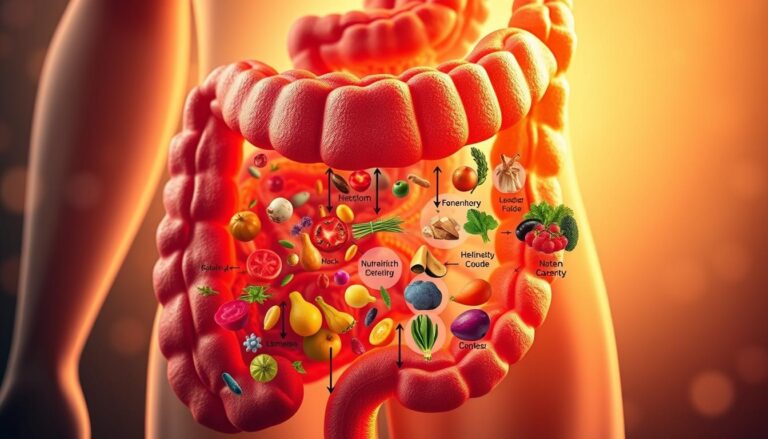Could intermittent fasting be the secret to losing weight? It’s a popular diet that’s getting a lot of attention. People say it helps with weight management and health. But does it really work fast? Let’s look into the science and find out how to lose weight with it.
Key Takeaways
- Intermittent fasting is an eating plan that alternates between fasting and eating periods
- It focuses on when to eat rather than what to eat, and has shown promise for fat loss and improved health
- Intermittent fasting can be adapted to various lifestyles and has been associated with benefits like weight loss, improved cognitive function, and better heart health
- Proper implementation and understanding the science behind it are crucial for successful long-term results
- Consult with a healthcare professional before starting any new dietary regimen, especially if you have any underlying health conditions
Understanding the Science Behind Intermittent Fasting
Intermittent fasting is more than a diet for losing weight. It causes deep changes in the body. When fasting, the body uses up its glucose and starts burning fat. This is called metabolic switching.
This change leads to more human growth hormone HGH and less insulin. Both can help with health.
The role of hormones is key in fasting’s effects. Lower insulin makes the body more sensitive to it. This improves insulin sensitivity.
This can help control blood sugar and lower the risk of metabolic disorders like type 2 diabetes.
Fasting also starts important repair processes. One is autophagy, where the body gets rid of damaged cells. This can help with health and even longevity.
The metabolic switching in fasting is a big reason for its benefits. The body starts using fat instead of glucose, entering ketosis. In this state, the brain and other tissues prefer ketones over glucose.
This can improve brain function and health. It might even help with conditions like epilepsy and Alzheimer’s.
Knowing the science behind intermittent fasting is important. It helps people get the most out of this diet. Fasting can lead to better health, from weight loss to living longer and preventing diseases.
Different Types of Intermittent Fasting Methods
Intermittent fasting comes in many forms. Each method has its own way of timing fasting periods. They can fit into different lifestyles and preferences. Let’s look at some popular ones:
- The 16/8 Method: This method has a 16-hour fast followed by an 8-hour eating window. You can eat and snack during the 8 hours. It’s a favorite among many.
- The 5:2 Diet: You eat normally for 5 days and then limit calories to 500-600 on the other 2 days.
- Eat-Stop-Eat: This involves fasting for 24 hours, once or twice a week. You don’t eat solid foods during this time.
- The Warrior Diet: It’s a strict method with a 20-hour fast and a big meal at night. It’s considered extreme.
Each method has its own timing and fasting duration. It’s key to pick one that fits your life and health goals. Talking to a healthcare expert can help choose the right one for you.

Intermittent fasting is not a one-size-fits-all approach. Experiment and find the method that works best for your body and schedule. Nutrition Expert, Jane Doe
The 16/8 Method: Most Popular Fasting Protocol
The 16/8 intermittent fasting method, also known as the Leangains protocol, is very popular. It helps with weight loss and better metabolic health. You fast for 16 hours and eat in an 8-hour window each day.
By timing your meals right, you can get the most out of this fasting method. It’s a great way to reach your health and fitness goals.
How to Structure Your Eating Window
The 16/8 method is flexible. You can pick an 8-hour eating window that works for you. Some people eat from 7 a.m. to 3 p.m., while others prefer 9 a.m. to 5 p.m.
The important thing is to stick to your schedule. Consistency is key for success with this fasting protocol.
Ideal Meal Timing for Maximum Results
Timing your meals right in the 8-hour window is crucial. Eating in sync with your body’s natural rhythms can improve your metabolism.
For example, eating most of your calories in the morning is better than eating them at night. This can lead to better metabolic results.
Breaking Your Fast Properly
When you break your fast, do it slowly and with healthy foods. Avoid eating too much or too late. This can cause discomfort and reduce the fasting benefits.
Instead, eat lean proteins, healthy fats, and fiber-rich carbs. These foods give you energy and support your health.

Understanding the 16/8 method and using it well can unlock many benefits. These include weight loss, better metabolic health, and overall well-being.
Intermittent Fasting: How to Lose Weight Fast
Intermittent fasting is a great way to cut calories, lose fat, and manage weight. Research shows it can help people lose 0.8% to 13% of their starting weight. It works by reducing calorie intake, burning more fat when fasting, and changing hormones for better weight loss.
But it’s key to eat well during the times you’re allowed to eat. Eating too much or unhealthy foods can spoil the benefits. By finding the right balance between fasting and eating you can get the most out of this method.
| Benefit | Findings |
|---|---|
| Weight Loss | Intermittent fasting has been shown to lead to weight loss ranging from 0.8% to 13% of participants’ starting weights. |
| Metabolic Improvements | Research indicates that intermittent fasting can have positive effects on inflammation, gut microbiota, and carbohydrate metabolism. |
| Potential Longevity Effects | Some studies suggest that intermittent fasting may have benefits for autoimmune disorders and could potentially contribute to extending lifespan. |
It’s important to remember that intermittent fasting isn’t for everyone. People with certain health issues a history of eating disorders, or who are pregnant or breastfeeding should talk to a doctor first.

Adding intermittent fasting to a healthy lifestyle can help with calorie control, fat loss, and weight management. But it’s important to do it carefully and with the help of health experts especially if you have health concerns.
Health Benefits Beyond Weight Loss
Intermittent fasting does more than help you lose weight. It also improves insulin resistance and blood sugar control. This makes your body more responsive to insulin, lowering the risk of type 2 diabetes.
This fasting method also starts autophagy. It’s like a body detox where damaged cells are removed and recycled. This process may help you live longer and fight off age-related diseases.
Brain Health Improvements
Intermittent fasting is good for your brain too. It boosts the production of brain-derived neurotrophic factor BDNF. This protein helps your brain cells grow and survive. It may protect against Alzheimer’s and Parkinson’s, improving memory and learning.
| Benefit | Explanation |
|---|---|
| Insulin Sensitivity | Intermittent fasting can improve insulin sensitivity, reducing the risk of type 2 diabetes. |
| Cellular Repair | Fasting triggers autophagy, a process that removes damaged cells and recycles their components, contributing to longevity. |
| Brain Health | Intermittent fasting can increase BDNF, a protein that promotes neuronal growth and survival, potentially benefiting conditions like Alzheimer’s and Parkinson’s disease. |

While losing weight is a big plus intermittent fasting offers even more benefits. It improves insulin resistance, boosts cellular function, and enhances cognitive function. Adding it to your routine can lead to many long-term health gains.
What to Eat During Your Eating Windows
When you practice intermittent fasting, what you eat matters a lot. Choose foods that are full of nutrients to help you stay healthy and lose weight.
Make sure your diet is balanced. Include proteins, healthy fats, and complex carbohydrates. Good protein sources are lean meats, fish, eggs lentils, and chickpeas. For healthy fats, try avocados, nuts, seeds, and olive oil. Whole grains, sweet potatoes, and quinoa are great for complex carbs.
Also, eat lots of fruits and vegetables. They are packed with vitamins, minerals, and antioxidants. Eating a variety of colorful fruits and veggies is best.
Drinking plenty of water is important too. It helps your body work right and stops you from eating too much.
The main thing is to eat whole, nutrient-dense foods. These foods will feed your body well and keep you full during fasting times.
| Food Category | Recommended Options |
|---|---|
| Proteins | Lean meats, fish, eggs, lentils, chickpeas |
| Healthy Fats | Avocados, nuts, seeds, olive oil |
| Complex Carbohydrates | Whole grains, sweet potatoes, quinoa |
| Fruits and Vegetables | Variety of colorful produce |
| Hydration | Water |
Fueling your body with nutrient-dense foods during your eating windows is crucial for maximizing the benefits of intermittent fasting.

Common Mistakes to Avoid When Fasting
Intermittent fasting can help with weight loss and health. But, it’s key to avoid common mistakes. Eat well during your eating times and listen to your body.
Overeating During Eating Windows
Many people eat too much during their eating times. This can cancel out fasting’s benefits. Binge eating or eating too much junk food can cause weight gain.
Choosing Wrong Foods
Eat nutrient rich, whole foods during your eating times. Avoid processed or highcalorie foods. Lean proteins, veggies, and complex carbs keep you full and satisfied.
Incorrect Fasting Duration
Finding the right fasting schedule is crucial. Fasting too short may not help, while too long can cause fatigue and muscle loss. Listen to your body to find the right balance.
Avoid these mistakes and fast mindfully. This way, you can reach your health and weight loss goals.
| Mistake | Potential Consequences | Recommendation |
|---|---|---|
| Overeating during eating windows | Negates calorie deficit, leads to weight gain | Focus on nutrient-dense, whole foods avoid binge eating and excessive junk food consumption |
| Choosing unhealthy foods | Undermines the benefits of fasting, contributes to poor health | Prioritize lean proteins, fibrous vegetables, and complex carbohydrates |
| Incorrect fasting duration | Insufficient metabolic benefits or adverse effects like fatigue and muscle loss | Gradually adapt to the right fasting schedule for your body and lifestyle |
The key to successful intermittent fasting is finding the right balance between discipline and flexibility, and listening to your body’s signals throughout the process.
Safety Considerations and Who Should Not Fast
Intermittent fasting can help many people lose weight. But, some groups need to be careful or not fast at all. Pregnant or breastfeeding women, people with diabetes or low blood pressure, and those with eating disorders should talk to a doctor first.
Fasting can be risky for these groups. It might make health problems worse or cause new ones. Pregnant and breastfeeding women need more nutrients, and fasting could harm them and their babies.
People with diabetes or low blood pressure might see their blood sugar or blood pressure drop too low. This could lead to serious health issues. Those with eating disorders might start to eat less in unhealthy ways, which is bad for their health.
If you’re thinking about fasting, talk to a doctor, especially if you have health issues. A doctor can help make sure fasting is safe and right for you.
| Group | Recommendation |
|---|---|
| Pregnant or Breastfeeding Women | Avoid fasting due to increased nutritional needs |
| Individuals with Diabetes or Low Blood Pressure | Consult a healthcare provider before fasting to manage health risks |
| Those with a History of Eating Disorders | Avoid fasting to prevent triggering unhealthy eating patterns |
| Children and Adolescents | Consult a healthcare provider before considering fasting |
Knowing who should avoid fasting helps people make smart choices about their health. This is important when trying intermittent fasting for weight loss.
Tips for Successful Long-term Fasting
Starting a long-term fasting journey needs a slow start. Let your body get used to the new routine. Drinking lots of water is key during fasting to keep your body working right.
Plan fun activities to keep your mind off food. This makes fasting easier. Pick a fasting method that fits your life and tastes. Whether it’s 16/8 or alternate-day fasting, choose what you can keep up with.
When you eat, eat foods that are good for you. A diet full of whole foods helps your health. Don’t eat too much, as it can mess up fasting’s benefits. Eat mindfully and stay disciplined for the best results.
| Intermittent Fasting Method | Description | Average Weight Loss |
|---|---|---|
| 16/8 Fasting | Fasting for 16 hours, eating during an 8-hour window | Almost 3% of body weight in 3 months |
| Time-Restricted Eating | Eating most calories by 1 p.m. daily | No significant difference in weight loss compared to typical eating patterns |
| Alternate-Day Fasting | Fasting every other day, eating normally on non-fasting days | 0.8% to 13.0% of initial weight loss in various studies |
Follow these tips to make fasting a long-term success. Enjoy the health perks that come with this lifestyle change.
Intermittent fasting has shown promise for the treatment of obesity, according to the 2020 systematic review.
Conclusion
Intermittent fasting is a flexible way to lose weight and improve health. Studies show it can help with weight metabolic health and cell repair. But, it’s important to start slowly and listen to your body.
It’s key to talk to doctors before starting. Choose a fasting plan that fits you. And eat well when you can eat.
Intermittent fasting has many benefits like losing weight and better blood sugar control. But, we still need to learn more about its long term effects. People with health issues should be careful and talk to doctors first.
Intermittent fasting can be a good way to lose weight and get healthier. But, it’s important to do it in a way that feels right for you. By understanding how it works, you can make it part of a healthy lifestyle.





